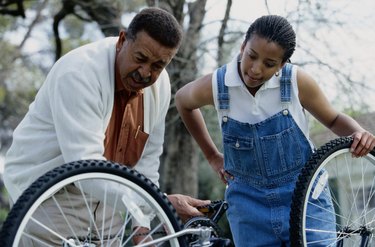
Clicking sounds coming from bicycle wheels indicate something is out of adjustment or needs maintenance. Spokes and wheel bearings are potential noisemakers. Clicking or chattering at the rear wheel when you pedal suggests the freewheel may be the source. A rear wheel that clicks when you coast indicates the internal part of the wheel hub needs servicing. If you're certain the noise is not coming from the bottom bracket or a derailleur, determine the wheel that's clicking and stage your bike tools in the work area.
Front Wheel
Video of the Day
Step 1
Elevate the front wheel using a stand under the lower frame tube, or turn the bike over and balance it on the seat and handlebars. Build up wood blocks under the frame and park the bike on its kickstand.
Video of the Day
Step 2
Take a position close to the front wheel. Spin the wheel briskly by hand and listen closely. Clicking at the area of the rim indicates loose spokes or dry spoke nuts. Jiggle each spoke by hand to locate loose spokes. Tighten the spoke nuts on loose spokes with a spoke wrench.
Step 3
Apply two drops of lightweight oil at the base of each spoke nut where it meets the rim. Apply two drops of oil on the crossovers at each pair of spokes.
Step 4
Put your safety glasses on to protect against oil splatter. Spin the wheel again. A quiet wheel tells you the source was loose or dry spokes. Persistent clicking coming from the wheel hub indicates loose or dry wheel bearings. Loosen and remove the axle nuts with a metric socket wrench and take the wheel off the bike to service the wheel.
Step 5
Stand the wheel on the floor. Attempt to move the axle back and forth in the hub by hand. Tighten the cone nuts on each side in equal increments with a cone wrench just enough so the axle does not move back and forth.
Step 6
Mount the wheel on the bike and tighten the axle nuts. Spin the wheel by hand. Persistent clicking at the wheel hub indicates dry bearings. Remove the wheel and place it on a worktable.
Step 7
Loosen and remove the cone nuts on each side of the hub with a cone wrench or adjustable wrench. Pull the axle out of the hub from one side. Remove the bearing cone and wheel bearing from the end of the axle. Remove the bearing cone and bearing from the other side of the hub by hand.
Step 8
Inspect each bearing closely. Replace a bearing if you note damaged or missing ball bearings. Apply bearing grease on each bearing and on the axle.
Step 9
Reinstall the axle bearings and bearing cones into the hub in the reverse order as removed. Tighten the cone nuts in equal increments as before. Mount the wheel on the bicycle and tighten the axle nuts securely.
Rear Wheel
Step 1
Elevate the rear wheel using a stand under the lower frame tube, or turn the bike over and balance it on the seat and handlebars.
Step 2
Jiggle each spoke by hand. Tighten any loose spokes with the spoke wrench. Apply two drops of oil on each spoke nut where it meets the wheel rim. Apply two drops of oil on the crossovers at each pair of spokes. Wear safety glasses and rotate the pedal cranks rapidly by hand. Inspect the freewheel and hub if you hear persistent clicks at the wheel hub.
Step 3
Loosen the axle nuts and lift the chain off the rear sprocket. Remove the brake-arm clip on a coaster brake. Take the wheel off the bike and place it on a worktable with the sprocket facing up.
Step 4
Install a lock ring tool in the splines on the sprocket. Attach a cone wrench on the cone flats between the sprocket and hub as a backup. Attach an adjustable wrench on the flats of the lock ring tool. Hold the handle of the cone wrench steady with one hand as you loosen and remove the lock ring with the adjustable wrench.
Step 5
Pull the sprocket off the freewheel by hand. Inspect the freewheel cogs for cracks or broken sections. Refer to the procedures in your repair manual and replace a damaged freewheel. Grease the inside of the wheel hub and reattach the sprocket using the removal procedure in reverse. Mount the wheel on the bike and reconnect the chain before tightening the axle nuts.
Things You'll Need
Service manual for your bicycle
Safety glasses
Spoke wrench
Lightweight oil
Metric socket wrench
Cone wrench
Bearing grease
Adjustable wrench
Lock ring tool
Tip
Some clicks are audible only when riding the bike. Ask a bike mechanic for suggestions or help with this type of problem. Lock ring tools are sprocket specific. Ask a bike shop to recommend the correct lock ring tool.